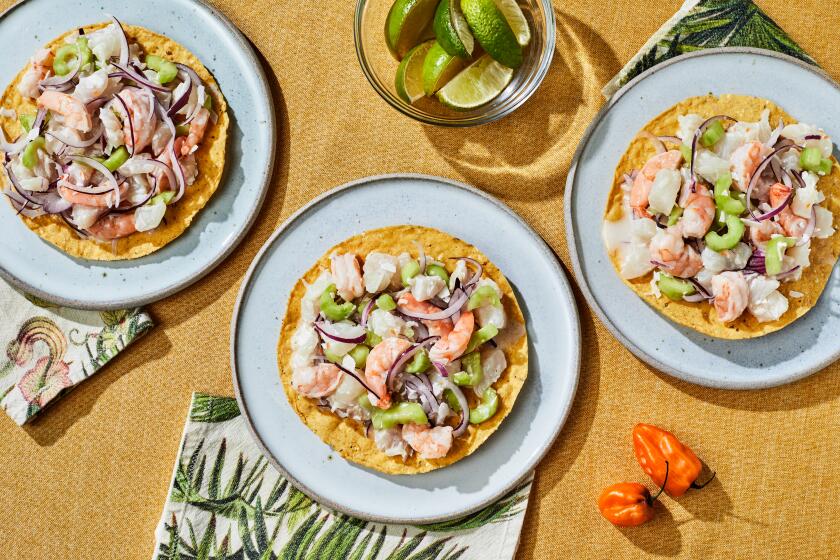Blini with Caviar

The pitchmen and infomercials rise up in such force at holiday time that it seems you could stock a kitchen entirely with their beguiling but useless gizmos. The worst part is that all that rubbish obscures the tools that are truly useful for the home cook.
The following are some of the professional kitchen tools we believe are essential for a serious home cook. They fall into three general categories: 1) tools that bring a textural luxury or a clarity of flavor; 2) tools that help you do things more easily; and 3) common appliances or tools that have become neglected or are badly misunderstood.
The chinois and the tamis are two essential implements of refinement, separating what is extraneous (vegetable fibers, cellulose, bits of curdled egg or herbs and spices that have been used for infusing in a puree, stock or sauce) from what is essential.
The chinois, a conical fine-meshed strainer, is used for liquids. In refined cooking, no liquid should move from one pan to another except through a chinois. (Just rap the rim to help liquid pass through it; never plunge with a ladle, because that defeats the point by pushing through fine bits of the stuff you want kept out.)
The tamis, or drum sieve, is essential for refining more solid purees, such as vegetables, or for pureed meats and fish that will become a pa^te or terrine. It can also be used as a sifter in baking.
There are many tools used in professional kitchens that make everyday tasks easier. The Silpat is one. It is a flexible silicon nonstick liner for baking sheets. You can use a Silpat to make Parmigiano-Reggiano chips, tuiles or even cookies.
The mandoline is another tool that cuts down on a lot of labor. It is, essentially, an automatic slicer--a rack with a very sharp knife blade that you push food against, cutting it in very thin slices. Real mandolines, which will do all sorts of fancy things like waffle cuts, are expensive, some of them more than $200. But the plastic mandolines like the one made by the Japanese Benriner company will do everything most home cooks will need for less than $40.
Then there are the things you may already have but probably don’t use. Something as simple as a scale is easy to overlook, but it is essential in any serious home cook’s kitchen because it ensures proper measurements. When measuring by volume--cups and tablespoons--amounts can vary considerably. Measuring by weight is far more accurate and ensures consistent results.
Anyone who’s followed modern cooking knows that juicers are not just for juice anymore. You can put raw or cooked vegetables through them for quick, extraordinary soups and sauces.
But the big tool that is forgotten is the blender. Too often, when folks tired of frozen margaritas, the blender was abandoned in a cupboard. Yet it’s a fundamental appliance in the professional kitchen, used for pureeing soups and sauces. And consider the submersion blender, a blender blade on the end of a stick that allows you to puree soups and emulsify sauces in their cooking pots.
And don’t neglect the common-sense basics. In addition to good, heavy pots and pans, you need good heavy baking sheets (not those ripply brown things Mom used when you were a kid), a pepper mill that really grinds (no more chunks of pepper, please) and a palette knife to replace those abusive tongs.
Remember, with a good blender and a chinois, you can go almost anywhere.
Place potatoes in pot, cover by 2 inches with cold water and bring to a boil. Reduce heat to simmer and cook until tender, about 25 minutes. Drain.
While still warm, peel potatoes and pass them through tamis. Weigh out 9 ounces of resulting puree (about 1 3/4 cups, packed). Working quickly, whisk flour into potatoes, then whisk in creme frai^che. Add 1 egg, whisking batter until smooth. Add second egg, and then yolk, whisking until smooth. Batter should fall from whisk in thick stream but hold its shape. Add a little more creme frai^che if batter is too thick. Season with salt and pepper to taste.
Heat nonstick pan over medium-low heat. Spoon 1/2 tablespoon of batter into skillet for small blini, more for larger blini as desired. Cook 2 minutes, flip and continue cooking another minute or until done. Blini should be golden brown. Keep warm while you make successive batches.
Serve immediately, topped each with a dollop of caviar.
Get our Cooking newsletter.
Your roundup of inspiring recipes and kitchen tricks.
You may occasionally receive promotional content from the Los Angeles Times.















